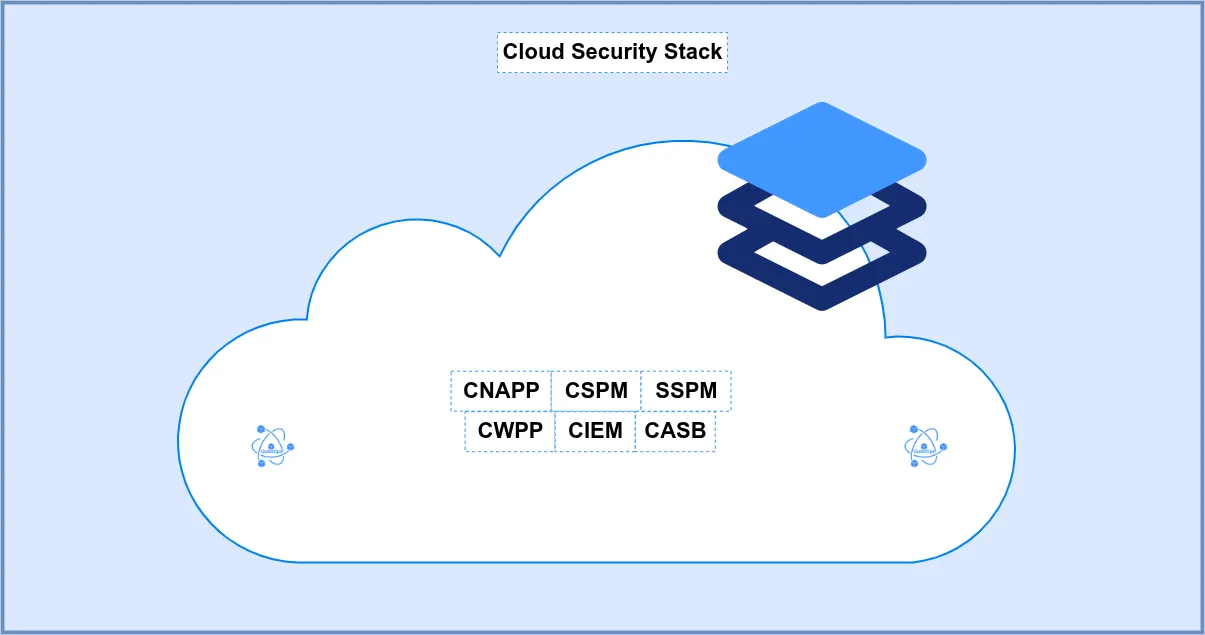
Introduction
As organizations accelerate their cloud adoption, securing cloud environments becomes increasingly complex. The cloud security stack is designed to address different layers of cloud security. Here’s a breakdown of the key components, along with a comparison of their roles and focus areas:
1. CNAPP (Cloud-Native Application Protection Platform)
- Focus: Unified protection for cloud-native applications, workloads, and containers across their lifecycle.
- Use Case: Securing microservices architectures, containerized workloads, and development pipelines.
- Strength: Combines workload security, runtime protection, and shift-left principles for DevSecOps.
2. CSPM (Cloud Security Posture Management)
- Focus: Identifying and remediating misconfigurations in cloud environments.
- Use Case: Ensuring compliance with frameworks like GDPR, HIPAA, or NIST.
- Strength: Provides visibility into security gaps and automates policy enforcement across multi-cloud setups.
3. SSPM (SaaS Security Posture Management)
- Focus: Securing SaaS applications by managing their configurations and permissions.
- Use Case: Monitoring SaaS platforms like Office 365, Salesforce, or Google Workspace for risky misconfigurations.
- Strength: Reduces the risk of unauthorized access or data leaks in SaaS applications.
4. CWPP (Cloud Workload Protection Platform)
- Focus: Protection of workloads such as VMs, containers, and serverless functions.
- Use Case: Vulnerability management, runtime protection, and intrusion detection for workloads.
- Strength: Specialized security for dynamic and ephemeral workloads in hybrid or multi-cloud setups.
5. CIEM (Cloud Infrastructure Entitlement Management)
- Focus: Managing identity and access permissions in cloud environments.
- Use Case: Detecting excessive privileges and enforcing least-privilege access.
- Strength: Addresses identity-related risks, a common vector for cloud breaches.
6. CASB (Cloud Access Security Broker)
- Focus: Bridging on-premise and cloud security by monitoring and protecting cloud application usage.
- Use Case: Preventing data loss and shadow IT while ensuring secure access to cloud applications.
- Strength: Visibility into cloud usage and real-time data loss prevention (DLP).
Comparison Table
| Feature | CNAPP | CSPM | SSPM | CWPP | CIEM | CASB |
|---|---|---|---|---|---|---|
| Primary Focus | Application Security | Posture Management | SaaS Configuration | Workload Protection | Identity Management | Cloud Access Security |
| Key Use Case | Securing workloads, containers | Compliance & Misconfigurations | Securing SaaS applications | Vulnerability scanning | Privilege enforcement | Shadow IT, DLP |
| Cloud Layer | Workloads & Apps | Configurations | SaaS | Workloads | Identity | Access & Apps |
| Strength | Unified security for DevSecOps | Multi-cloud visibility | SaaS risk reduction | Runtime protection | Least-privilege enforcement | Real-time threat mitigation |
| Examples | Prisma Cloud, Wiz | AWS Config, Lacework | Adaptive Shield | Trend Micro, Aqua Security | Zscaler CIEM | Netskope, McAfee CASB |
Conclusion
Each tool in the cloud security stack serves a unique purpose but complements the others for a comprehensive cloud security strategy. While CNAPP excels in application security and DevSecOps, CSPM ensures compliance and cloud hygiene. SSPM fills the SaaS security gap, while CWPP focuses on protecting workloads. CIEM strengthens identity security, and CASB ensures secure cloud access and data protection.
By combining these tools, organizations can create a multi-layered defense tailored to their specific cloud environments. Are you leveraging the full potential of the cloud security stack? Share your insights in the comments!